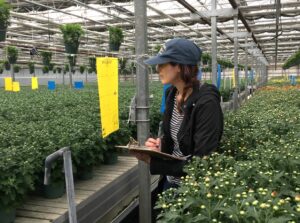Biological control against unwanted pests
Madi Schafer
- September 26, 2023
Promoting sustainable, biological-based pest management alternatives, biological control and Integrated Pest Management (IPM) programs are proven to maintain overall quality control, increase yield and create a healthy environment. Biological control while using beneficial insects takes corrective measures to deter unwanted pests from causing significant damage while ensuring minimal risk to the environment. During the 2023 Great Lakes Fruit, Vegetable and Farm Market EXPO, attendees will gain more insight on biological control and biological-based pest management.

Suzanne Wainwright-Evans, a horticulture entomologist specializing in biological control and bio-pesticides, professionally teaches workshops, sessions and lectures to the agriculture industry — bringing her scientific expertise and practical approach to growers.
During the Great Lakes EXPO, Wainwright-Evans will inform growers of the importance of a bio-controlled program through her session, “A Deeper Discussion on Beneficials.”
“With this session, I’m hoping I can give growers information about the beneficials they’re using,” Wainwright-Evans said. “My experience in working with the beneficials and researchers can give growers more actionable information they can utilize in their pest management programs.”
According to Wainwright-Evans, there has been a recent increase in the use of micro and macro beneficials. By incorporating beneficials and microbials into a grower’s program, pesticides do not have to be applied as often, ultimately reducing the risk of developing resistance.
“The major reason why people contact me to incorporate beneficials is that they are struggling to manage pests with conventional chemistry because of resistance (to pesticides),” Wainwright-Evans said.
Wainwright-Evans also mentions that growers using beneficials won’t have to shut down their greenhouse when implementing them into their program – another bonus to using beneficial insects. When using beneficials, it’s important to know what unwanted pests growers are dealing with. Growers should utilize a systems approach when using beneficials to best understand how they can be impacted.
“It’s important to identify what your problem is. You’ve got to know what your pest is so you can best select your pest management program,” Wainwright-Evans said. “You have to watch what spray products are used in your program while using beneficials because even things like fungicides and plant growth regulators can impact beneficials.”
Sarah Jandricic, Greenhouse Floriculture IPM specialist for the Ontario Ministry of Agriculture, Food and Rural Affairs (OMAFRA) in Ontario, Canada, brings new IPM products and procedures from researchers to Ontario growers and helps them implement them practically. Jandricic also helps guide researchers on what they need to work on based on the specific needs of growers.
During the Great Lakes EXPO, Jandiric will walk through an IPM program titled “A systems approach to greenhouse biological control,” and will discuss a key pest of ornamentals – western flower thrips – from start to finish.

“This program has been highly successful in Canada. Over 90% of our growers almost exclusively use biocontrol in Ontario. Most of this is driven by the need to control western flower thrips in an effective, reliable and economical way,” Jandricic said. “Pesticides just weren’t working for us and growers don’t enjoy using them. Developing this program over the last two decades has helped growers get off the pesticide treadmill.”
Jandricic’s session, she will explain how biocontrol best works by starting as clean as possible and dipping cuttings in reduced-risk pesticides such as soap and oil.
“By reducing pest pressure at the beginning, you set your natural enemies up for success and may need fewer of them,” she said. “We then use different approaches in propagation versus production, as these environments can be quite different. What works in one might be unnecessary or too costly in the other. Best practices for biological control also involve monitoring pest levels throughout the crop to know if you need to add in other biocontrols or other IPM strategies.”
According to Jandricic, with biocontrol, it’s important to incorporate other non-chemical IPM strategies so growers can have a well-rounded, resilient management program.
“I love sticky tape and mass-trapping cards! A lot of growers seem to avoid using them because they are afraid they will trap and kill too many of their natural enemies, Jandricic said. “This is a valid concern, but in practice, we don’t see this. And, the traps can help reduce incoming pests, meaning your biocontrol agents can keep up with them.”
Ultimately, Jandricic is a major advocate for biological control and encourages growers to implement the practice within their pest management programs.
“Biological control is fun. Growers in Ontario love talking about their biocontrol control programs, watching the biocontrol agents work and comparing notes with other growers. Nothing beats a clean, high-quality crop at the end of the crop cycle where you don’t have to put on a spray suit.”
Learn more about these sessions and others at www.glexpo.com. The 2023 Great Lakes EXPO will be held Dec. 5-7 at DeVos Place in Grand Rapids, Michigan.
